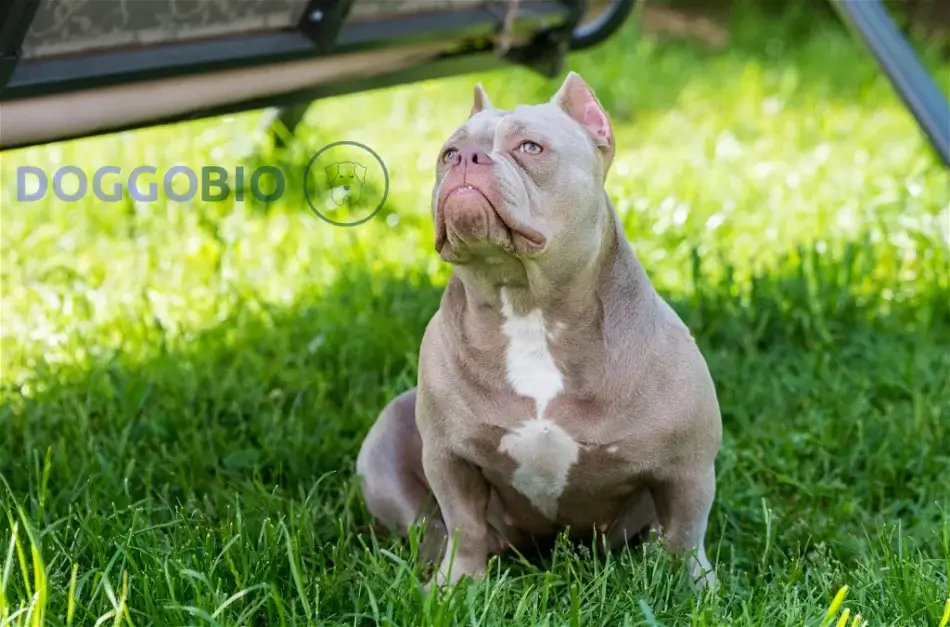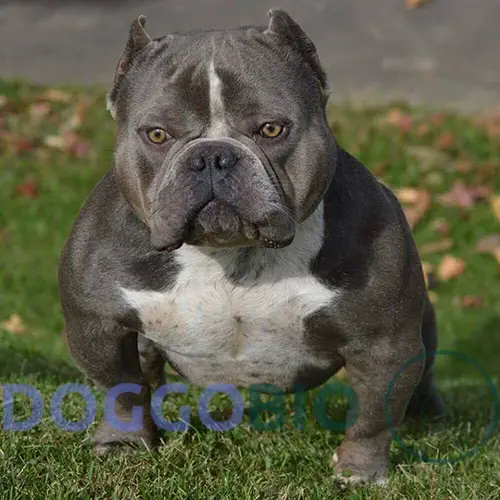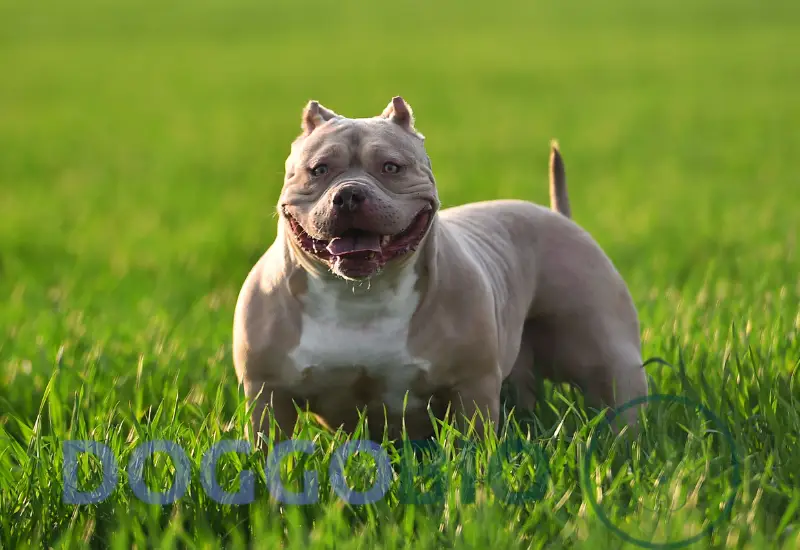The exotic bully, a unique and captivating breed, has captured the hearts of dog enthusiasts worldwide. With its striking appearance, muscular build, and endearing personality, the exotic bully stands out as a visually stunning and incredibly affectionate dog breed.
This remarkable canine companion combines the physical attributes of the American Bully with a touch of exotic influence, resulting in a breed that truly stands apart from the rest.
This introduction will explore the exotic bully’s origins, characteristics, and popularity, delving into why it has become a beloved breed among dog lovers everywhere.
A Brief Overview of Exotic Bully
| Other Names | Exotics |
| Breed Type | Crossbreed |
| Special Features | Muscular build, distinctive appearance |
| Weight Range | 55-75 pounds (24-34 kg) |
| Height Range | 14-16 inches (35-41 cm) |
| Colors | Brown, White, Chestnut, and Brown |
| Coat Type | Short |
| Temperament | Friendly, confident, and protective |
| Grooming Level | Low |
| Health Issues | Generally healthy, but watch for obesity |
What Is an Exotic Bully?

The Exotic Bully is a distinct breed resembling the American Bully but with exaggerated features reminiscent of smaller Bulldog breeds. With larger heads, broader chests, and shorter muzzles, they stand out as a visually striking breed among Bull varieties. Created through the introduction of diverse breeds, the Exotic Bully captures the attention of dog enthusiasts globally with its unique allure.
History of American Exotic Bully
The history of the Exotic bully traces back to its creation in early 2008, marking its emergence as a newer breed separate from its relative, the American Bully. Despite establishing itself as a distinct breed, the Exotic bully remains a subject of controversy surrounding its breed standard.
However, it is widely recognized that the Exotic Bully is a crossbreed, incorporating various Bully breeds such as the Olde English Bulldog, American Bully, Shorty Bull, English Bulldog, and French Bulldog.
What Does a Exotic Bully Look Like?
In terms of appearance, although not officially recognized, the Exotic bully shares many attributes with other Bull breeds, including the pit bull, Bulldog, American Bully, and others. These exotic bullies possess short and stout bodies characterized by broadness and a strong bone structure. They exhibit remarkable strength and exude confidence.
When interacting, the dog may display intimidating behavior. Its forelegs are noticeably short, contributing to a dwarf-like appearance. Additionally, the breed boasts a robust tail that is not thin or whippy.

Size, height, and Weight
While Exotic Bullies share a similar appearance and name with their American counterparts, they are notably smaller and lighter. However, they maintain a healthy muscle tone and body size.
When fully grown, Exotic Bullies typically reach a height of up to 13 inches. In terms of Weight, they usually range from 30 to 50 pounds. Although slight variations in individual sizes may exist, they generally fall within these average ranges.
Coat colors and Types
The appealing quality of this breed is its diverse coat colors. With over 20 options, finding a unique puppy is effortless. Accepted by registries, colors include:
- Black,
- Cream,
- Gray,
- Chocolate,
- Blue,
- Red,
- White,
- Tri-color,
- And brindle.
- Merle is generally not accepted due to potential health concerns.
- Brindle patterns with unique tiger stripes add an exotic touch to these remarkable dogs.
Temperament and Personality
The Exotic Bully may appear intimidating at first glance, but they’re actually quite friendly towards humans and other dogs. Proper training and understanding between owner and dog are essential.
While they share traits with bulldogs, they don’t typically exhibit aggression. They’re sociable and enjoy bonding with their owners, often seeking affectionate “cuddle time.”
Training and Exercise Requirements
Training an Exotic Bully is a breeze due to their high intelligence and desire for attention. Early socialization is crucial for these small and delicate dogs to ensure they get along well with other dogs.
When it comes to exercise, moderation is key. While they benefit from regular physical activity, being mindful of their breathing difficulties and susceptibility to overheating is essential. Aim for around 30 minutes of daily walks to keep them fit and healthy.
Grooming and Cleaning
When it comes to grooming, the exotic bully boasts a smooth and short coat, making it a low-maintenance breed. While they shed some fur, it is less than other bully breeds. However, there are ways to reduce shedding.
One advantage of this breed is that their hair does not easily tangle, eliminating the need for extensive brushing. Bathing them a few times a month is sufficient, primarily if they get dirty from outdoor play.
Due to their short hair, exotic bullies do not require haircuts or trims. Occasionally, shaving their fur can help minimize shedding. Regular vet checkups are essential to ensure proper nutrition and overall well-being.
Food and Diet
When it comes to food and diet, the exotic bully does not have any specific dietary requirements. The ideal diet for exotic bully puppies and adult dogs consists of plenty of protein and low-fat food. However, it is always advisable to consult with your veterinarian regarding their specific dietary needs and feeding schedule.
Given their sensitive nature and potential health concerns, providing these exotic bully dogs with a healthy diet and regular physical exercise is crucial. This combination promotes their overall well-being and helps maintain their health.
Life Expectancy and Common Health Issues
When bred ethically, Exotic Bullies generally have fewer health issues. However, unethical breeding practices can lead to significant health problems. As a result, predicting the lifespan of an Exotic Bully becomes challenging, with estimates suggesting a maximum lifespan of around 5 years.

Here are some prevalent health issues to be aware of:
- Back Problems: Healthy backs are crucial for dogs, enabling them to move freely. Back pain can hinder mobility and affect their ability to walk, stand, lie down, or play.
- Hip Dysplasia: More common in larger breeds, hip dysplasia can also be observed in Exotic Bullies. It often manifests as bowing of the front and back legs.
- Joint Problems: Dogs can experience discomfort in their joints, especially as they age or due to weight gain. Veterinary care is typically required to address this issue.
- Brachycephalic Syndrome: Brachycephalic dogs, including Exotic Bullies, are prone to this condition characterized by an obstructed airway, leading to respiratory difficulties.
- Overheating: With their short-nosed faces, Exotic Bullies are susceptible to overheating and struggle in warm environments. Heat management is crucial for their well-being.
- Dental Problems: The brachycephalic skull structure can contribute to dental issues, such as tooth loss or overcrowding, causing discomfort and eating difficulties and potentially requiring tooth extractions.
- Short Life: Exotic Bullies are relatively new, requiring further modifications, resulting in a shorter lifespan.
- Ocular Problems: Exotic Bullies have an increased risk of eye defects and malformations, which can impair their vision and lead to various eye conditions.
Understanding these health concerns allows for informed care and proactive measures to promote the well-being of Exotic Bullies throughout their lives.
How Much Is An Exotic Bully?
Depending on factors such as breeder reputation, pedigree, and bloodline quality, prices for Exotic Bullies can range from $5,000 to over $10,000. Reputable breeders provide proper documentation, vaccinations, and health assurances for their puppies.
How Can I Find an Exotic Bully For Sale?

Places to Find Exotic Bully Puppies for Sale or Adoption:
If you’re in search of an Exotic Bully puppy, consider the following reputable sources:
- NWG Bullies: This breeder is known for producing top-quality dogs and provides each puppy with a purchase agreement and health guarantee. Various Bully clubs recognize their puppies for registration.
- Toadline Exotic Bully: They offer Exotic Bullies all necessary paperwork, a health certificate, and a seven-day health assurance. They also provide a satisfaction guarantee within specific timeframes.
- Venom Line: Known for producing physically healthy Bullies, they provide a contract, registration papers, and a health certificate issued by a qualified veterinarian.
For Adoption:
- Fresno Bully Rescue: Many Bullies are available for adoption, including exotic breeds. They offer puppies and adult dogs, allowing you to choose the best fit for your home. Adoption fees range from $125 to $220 based on the dog’s age.
- Don’t Bully Us Rescue: Located in the Philadelphia and South Jersey area, they microchip, vaccinate, and vet examine all their puppies and adult dogs. Dogs aged 6 to 8 months are spayed or neutered. Adoption fees range from $250 to $400, depending on the dog’s age.
These sources can provide Exotic Bully puppies or adult dogs, ensuring you find a new furry companion that suits your preferences and needs.
List of dogs that are similar to Exotic Bully
Frequently Asked Questions
What breeds make an Exotic Bully?
The Exotic Bully draws its lineage from a combination of the American Bully, English Bulldog, Old English Bulldog, and Short Bull.
While these are the primary ancestors, it’s worth noting that there may be other bulldog breeds that have contributed to the Exotic Bully’s genetic makeup.
What is A clean Exotic Bully?
A clean Exotic Bully is a dog that adheres to the breed’s classic characteristics without any documented abnormalities. It has a short, compact frame and exaggerated features and avoids issues like a sloping skull or weak jaw.
Desirable traits include a height of up to 13 inches, a muzzle length of no more than 2 inches, a condensed yet muscular build, proportionate height and length, acceptable dental configurations, and well-defined cheek muscles.
Are Exotic Bullies hypoallergenic?
No! It’s important to note that Exotic Bullies are not hypoallergenic. Although they have minimal shedding and short fur, they can still cause issues for individuals with dog allergies.
Are Exotic Bullies Aggressive?
No! Despite their intimidating appearance, Exotic Bullies are not naturally aggressive. On the contrary, they are known for their friendly nature, not only towards humans but also towards other dogs.
It’s important not to judge them based solely on their looks, as they can be affectionate and friendly companions.
Is an Exotic Bully Suitable for First-Time Owners?
Yes, an Exotic Bully is suitable for first-time owners. Exotic Bullies are low-maintenance dogs with short coats, which makes grooming easier for beginners. Additionally, they are highly trainable, making them an excellent choice for first-time pet owners who may be new to training.
With proper care and training, first-time owners can establish a strong bond with their Exotic Bully and enjoy a fulfilling companionship.
Conclusion
In conclusion, the exotic bully has undoubtedly carved a special place in the hearts of dog enthusiasts worldwide.
Its unique blend of physical features and friendly and affectionate temperament has made it a highly sought-after breed. From its origins rooted in the American Bully breed to the infusion of exotic influences, the exotic bully showcases a distinct appearance that sets it apart from other species.
Whether admired for its striking colors, impressive muscle definition, or playful nature, the exotic bully never fails to captivate those who encounter it. As its popularity continues to soar, it is essential to emphasize the importance of responsible ownership and proper training to ensure the overall well-being of this remarkable breed.
The exotic bully’s undeniable charm and unmistakable presence make it a breed that will undoubtedly leave a lasting impression on anyone lucky enough to encounter it.

Pingback: American Bully XL: Understanding Your Loyalty Companion 2024
Pingback: Pocket Bully Love: Petite Powerhouses Explored 2024